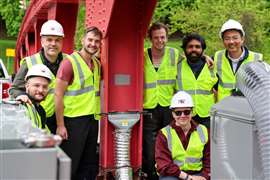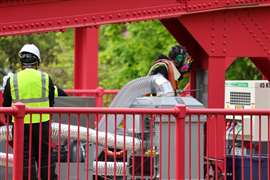Read this article in French German Italian Portuguese Spanish
MIT researchers claim breakthrough on 3D printing for bridge repairs
20 June 2025
 Members of the UMass Amherst and MIT Department of Mechanical Engineering research team, led by Simos Gerasimidis (left, standing) with the 3D printed patch. (Image: MIT)
Members of the UMass Amherst and MIT Department of Mechanical Engineering research team, led by Simos Gerasimidis (left, standing) with the 3D printed patch. (Image: MIT)
A team of researchers in the US claims that field tests have showed a novel 3D-printing technique can be used to repair the hundreds of thousands of bridges in the country that need attention.
A team led by the University of Massachusetts at Amherst in collaboration with researchers from the MIT Department of Mechanical Engineering (MechE) said cold spraying could reduce the repair cost of infrastructure and reduce disruptions to traffic.
They tested the technology on the “red bridge” in Great Barrington, Massachusetts, built in 1949. The technique involves spraying high-velocity metal powder particles to coat sections of steel beams on bridges. Repeated sprays create multiple layers, restoring thickness and other structural properties to the treated area.
MIT said that while the method has been applied to other large structures like submarines and aeroplanes, this is the first time it has been applied to bridges.
Bridges present a challenge due to their size and the fact that the 3D printer has to be brought on site.
But Simos Gerasimidis, associate professor of civil and environmental engineering at the University of Massachusetts Amherst, said, “Now that we’ve completed this proof-of-concept repair, we see a clear path to a solution that is much faster, less costly, easier, and less invasive. To our knowledge, this is a first. Of course, there is some R&D that needs to be developed, but this is a huge milestone to that.”
 The process speeds up powdered steel in compressed gas and then the technician uses an applicator to spray the steel onto the beam. Repeated sprays create multiple layers, restoring thickness and other structural properties. (Image: MIT)
The process speeds up powdered steel in compressed gas and then the technician uses an applicator to spray the steel onto the beam. Repeated sprays create multiple layers, restoring thickness and other structural properties. (Image: MIT)
The process involved 3D LiDAR scanning methods to replace visual assessments. That enables researchers to precisely identify corrosion, develop a digital repair plan and deposit the material only where necessary.
“By combining scanning with precise material deposition, we can be very targeted and say, ‘we’re going to print here and here and here and we’re going to give this bridge another 10 years of life,’ which is huge,” said Gerasimidis.
He added that the technique allows for cars to continue crossing while the bridge is sprayed, reducing disruptions to traffic.
The red bridge is set to be demolished in a few years. After that, the UMass team will take the sprayed beams back to their lab and test them, measuring how successfully the deposited steel powder adhered to the structure in the field compared to in a controlled lab setting. They will also be able to see if it corroded further after it was sprayed and determine its mechanical strength properties.
Some 49% of bridges in the US are only in “fair” condition and 6.8% are rated “poor,” according to the 2025 Report Card for America’s Infrastructure. The projected cost to restore them exceeds $191 billion, according to MIT.
John Hart, Class of 1922 Professor in the Department of Mechanical Engineering at MIT said, “This is a tremendous collaboration where cutting-edge technology is brought to address a critical need for infrastructure in the commonwealth and across the United States. I think we’re just at the beginning of a digital transformation of bridge inspection, repair and maintenance, among many other important use cases.”
STAY CONNECTED



Receive the information you need when you need it through our world-leading magazines, newsletters and daily briefings.
CONNECT WITH THE TEAM








